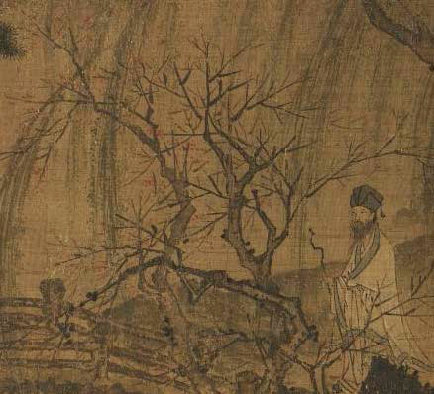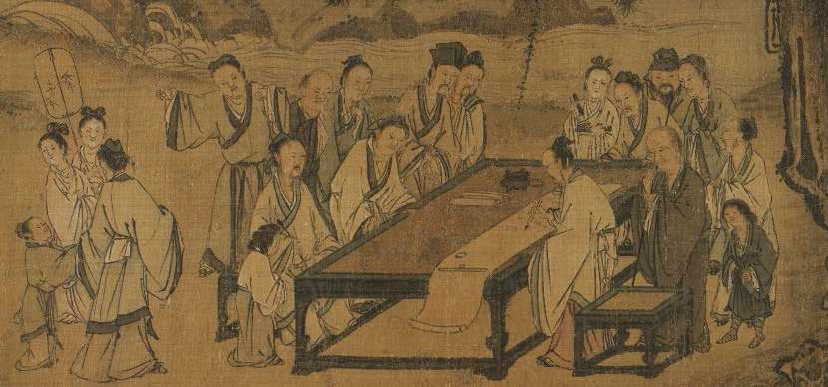Ink Plum Blossom: INTRODUCTION
Ink Plum Blossom: The mirror image of a scholar in the Song Dynasty
by Gerui Wang (University of Michigan, 2014)
Imagine yourself as a scholar, an official, or an artist in thirteenth century China, how would you spend leisure time during winter? How would you celebrate a beautiful day with your colleagues and friends? Bathing in gossamer moonlight of a winter night, one way that thirteenth century Chinese scholars (or literati), officials and artists would enjoy themselves was to attend a salon in a friend’s garden. Accompanying music and dance by the singing girls, they appreciate the flowering plum along the garden’s winding stream; after drinking wine, they write a poetry in response to a friend’s lines; some create paintings of plum blossoms, others inscribe commentaries in calligraphy on the painting.
The thirteen century admiration for plum blossom in China was not confined to intellectual gatherings. There was a demanding market for plum blossom that flower venders would force open the blossoms for profit.1 People at the capital could wander at the night market and buy a fan painted with plum. While wavering the fan, one could sip plum-blossom wine at teahouses with friends, where singing girls wearing jade plum blossoms pinned to their hair and were dressed up in moonlight colored garment.2
The intellectual gathering with plum appreciating event may be well portrayed in Composing Poetry on a Spring Outing (fig. 1), which is attributed to the Song Dynasty (960–1279) court painter Ma Yuan (active before 1189–after 1225). Modern art historians have observed a number of depictions in this painting that tally with physical features of the Jade-Radiance Hall—a garden of the Song poet and official Zhang Zi (1147–after1201), and events hosted in the garden.3 Among these features are the plum blossom growing by the winding stream (see detail 1), the gathering of scholars, monks, and females at the table wielding brush and ink (detail 2). Documentary materials from this time show that guests of Zhang Zi’s garden gathering involved famous literary figures such as Lu You (1125–1210), Yang Wanli (1127–1206) and the painter Ma Yuan.4
The painting Ink Plum Blossom (fig. 2) that you see on this web page was created in thirteen century China in this culture of enthusiasm for plum blossom. The painter on record is Yansou, who was most likely to be a scholar and an official. Yansou’s name was recorded in the imperial catalogue Shiqu baoji, but no biographical information was provided. Nonetheless it was mentioned that Yansou have represented plum blossoms “stretching out, looking up, dreaming, broken and falling.”5 There has been much debate identifying the exact date of Ink-Plum and who Yansou was in history. A recent exclusive study on this issue indicated that the painter should be poet He Menggui (1229–1303), whose courtesy name is Yansou, and the painting was created around 1274–1279, when He Menggui was an official in the city of Hangzhou.6

Fig. 1, Attributed to Ma Yuan (active ca. 1190–1225), Composing Poetry on a Spring Outing,
Date: 1127–1279; Nelson-Atkins Museum of Art
Detail 1 of Composing Poetry On A Spring Outing
Detail 2 of Composing Poetry On A Spring Outing
Section 1
Section 2
Fig. 2 Yansou, Ink Plum Blossoms, late 13th to mid–14th century, Handscroll, Ink on silk, 19.3 x 112.9 cm, Freer Gallery of Art
Want to know more? Look at the next page: WHAT IS THIS THING?
1. Bickford, Maggie. Ink Plum: the Making of a Chinese Scholar-painting Genre. Cambridge: Cambridge University Press, 1996, P.33↩
2. Bickford, Maggie. Ink Plum: the Making of a Chinese Scholar-painting Genre. Cambridge: Cambridge University Press, 1996 P.33↩
3. Ho, Wai-kam. Eight Dynasties of Chinese Painting: the Collections of the Nelson Gallery-Atkins Museum, Kansas City, And the Cleveland Museum of Art. Cleveland, Ohio: Cleveland Museum of Art, in cooperation with Indiana University Press, 1980. P.69↩
4. Bickford, Maggie. Ink Plum: the Making of a Chinese Scholar-painting Genre. Cambridge: Cambridge University Press, 1996 P.31↩
5. Sirén, Osvald. Chinese Painting: Leading Masters And Principles. London: Lund Humphries, 1956, Vol 2, P.160↩
6. Wu, Qiu-ye, “Exploring the author of Ink Plum Blossoms” in Journal of the study of Calligraphy and Painting (shuhua yishu xuekan), Vol. 13, P.157-172↩





